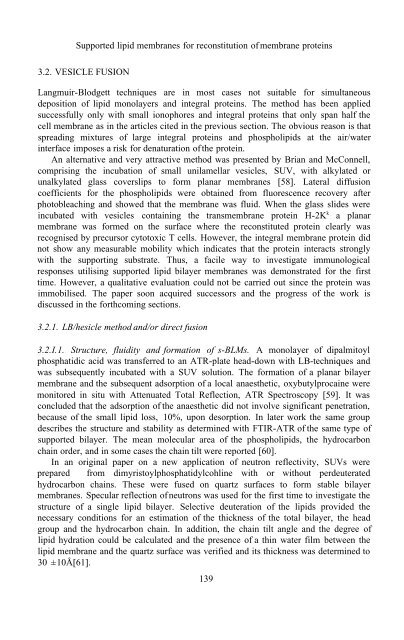Physics And Chemistry Basis Of Biotechnology - De Cuyper - tiera.ru
Physics And Chemistry Basis Of Biotechnology - De Cuyper - tiera.ru
Physics And Chemistry Basis Of Biotechnology - De Cuyper - tiera.ru
Create successful ePaper yourself
Turn your PDF publications into a flip-book with our unique Google optimized e-Paper software.
Supported lipid membranes for reconstitution of membrane proteins<br />
3.2. VESICLE FUSION<br />
Langmuir-Blodgett techniques are in most cases not suitable for simultaneous<br />
deposition of lipid monolayers and integral proteins. The method has been applied<br />
successfully only with small ionophores and integral proteins that only span half the<br />
cell membrane as in the articles cited in the previous section. The obvious reason is that<br />
spreading mixtures of large integral proteins and phospholipids at the air/water<br />
interface imposes a risk for denaturation of the protein.<br />
An alternative and very attractive method was presented by Brian and McConnell,<br />
comprising the incubation of small unilamellar vesicles, SUV, with alkylated or<br />
unalkylated glass coverslips to form planar membranes [58]. Lateral diffusion<br />
coefficients for the phospholipids were obtained from fluorescence recovery after<br />
photobleaching and showed that the membrane was fluid. When the glass slides were<br />
incubated with vesicles containing the transmembrane protein H-2K k a planar<br />
membrane was formed on the surface where the reconstituted protein clearly was<br />
recognised by precursor cytotoxic T cells. However, the integral membrane protein did<br />
not show any measurable mobility which indicates that the protein interacts strongly<br />
with the supporting substrate. Thus, a facile way to investigate immunological<br />
responses utilising supported lipid bilayer membranes was demonstrated for the first<br />
time. However, a qualitative evaluation could not be carried out since the protein was<br />
immobilised. The paper soon acquired successors and the progress of the work is<br />
discussed in the forthcoming sections.<br />
3.2.1. LB/hesicle method and/or direct fusion<br />
3.2. I. 1. St<strong>ru</strong>cture, fluidity and formation of s-BLMs. A monolayer of dipalmitoyl<br />
phosphatidic acid was transferred to an ATR-plate head-down with LB-techniques and<br />
was subsequently incubated with a SUV solution. The formation of a planar bilayer<br />
membrane and the subsequent adsorption of a local anaesthetic, oxybutylprocaine were<br />
monitored in situ with Attenuated Total Reflection, ATR Spectroscopy [59]. It was<br />
concluded that the adsorption of the anaesthetic did not involve significant penetration,<br />
because of the small lipid loss, 10%, upon desorption. In later work the same group<br />
describes the st<strong>ru</strong>cture and stability as determined with FTIR-ATR of the same type of<br />
supported bilayer. The mean molecular area of the phospholipids, the hydrocarbon<br />
chain order, and in some cases the chain tilt were reported [60].<br />
In an original paper on a new application of neutron reflectivity, SUVs were<br />
prepared from dimyristoylphosphatidylcohline with or without perdeuterated<br />
hydrocarbon chains. These were fused on quartz surfaces to form stable bilayer<br />
membranes. Specular reflection of neutrons was used for the first time to investigate the<br />
st<strong>ru</strong>cture of a single lipid bilayer. Selective deuteration of the lipids provided the<br />
necessary conditions for an estimation of the thickness of the total bilayer, the head<br />
group and the hydrocarbon chain. In addition, the chain tilt angle and the degree of<br />
lipid hydration could be calculated and the presence of a thin water film between the<br />
lipid membrane and the quartz surface was verified and its thickness was determined to<br />
30 + _10Å [61].<br />
139












